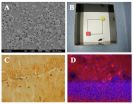(Press-News.org) Boulder, CO, USA — Venus is hiding something beneath its brilliant shroud of clouds: a first order mystery about the planet that researchers may be a little closer to solving because of a new re-analysis of twenty-year-old spacecraft data.
Venus's surface can't be seen from orbit in visible light because of the planet's hot, dense, cloudy atmosphere. Instead, radar has been used by spacecraft to penetrate the clouds and map out the surface – both by reflecting radar off the surface to measure elevation and by looking at the radio emissions of the hot surface. The last spacecraft to map Venus in this way was Magellan, two decades ago. One of the Venusian surprises discovered at that time is that radio waves are reflected differently at different elevations on Venus. Also observed were a handful of radio dark spots at the highest elevations. Both enigmas have defied explanation.
"There is general brightening upward trend in the highlands and then dark spots at the highest locations," explained Elise Harrington, an Earth sciences undergraduate at Simon Fraser University, in British Columbia, who revisited the Venus data during her internship at the Lunar and Planetary Institute, under the direction of Allan Treiman. Brightening, in this case, means the radio waves reflect well. Dark means the radio waves are not reflected. In other words, the higher you go on Venus, the more radio reflective the ground gets until it abruptly goes radio black.
"Like on Earth, the temperature changes with elevation," Harrington explained. And the cooler temperatures at altitude lead to ice and snow, which create a similar pattern of brightening for Earth – but in visible light. "Among the possibilities on Venus are a temperature dependent chemical weathering process or heavy metal compound precipitating from the air – a heavy metal frost."
Getting to the bottom of these mysteries has been very hard because Venus has not been revisited since Magellan and no better data is available.
So Harrington and Trieman made do by re-purposing the old data. They used recently-available stereo radar elevation data (from Dr. R. Herrick, University of Alaska) rather than using the lower resolution radar altimetry. That increased their altimetry resolution from seeing patches 8 by 12 kilometers to just 600x600 meters. They also used Magellan's Synthetic Aperture Radar (SAR), with its 75x75-meter footprint, to look at radio reflectance, rather than the data on radio emissions from the surface, which had a coarser 15 by 23 kilometer resolution.
They applied these to two areas in the Odva Regio highlands region of Venus where they confirmed the same pattern of radar reflections brightening with increasing elevation, as was found by previous researchers. The radar reflection was low at the lower 2,400 meter (7,900 foot) elevation, then rapidly brightens up to 4,500 meters (14,700 feet). But they also found a lot more of those strange black spots, with a precipitous drop in the reflections at 4,700 meters (15,400 feet).
"The previous author saw a few dark spots," said Harrington. "But we see hundreds of them."
Years ago it was proposed that some sort of ferro-electric compound might be the cause of the brightening and the dark spots, but so far no specific compound has been identified which does the trick. Then again, with the surface of Venus being at almost 900 °F (500 °C) under more than 90 times the air pressure of Earth's atmosphere at sea level, with occasional showers of acid, it's not easy to test the properties of materials under Venusian conditions.
"No one knows what explains the sudden darkness," said Harrington, who will be presenting the work at the meeting of the Geological Society of America in Vancouver, B.C., on Monday, Oct. 20. "We think this might spur some more interest in Venus."
INFORMATION:
Contact: Christa Stratton
+1-778-331-7625 during the meeting, 19-22 Oct. 2014
+1-303-357-1093 after the meeting
cstratton@geosociety.org
WHAT:
THE PUZZLE OF RADAR-BRIGHT HIGHLANDS ON VENUS: A HIGH-SPATIAL RESOLUTION STUDY IN OVDA REGIO
Abstract: https://gsa.confex.com/gsa/2014AM/webprogram/Paper242125.html
Session No. 136—Booth #266
T230. Topics in Planetary Geology (Posters)
WHO:
HARRINGTON, Elise, Department of Earth Sciences, Simon Fraser University, 8888 University Drive, Burnaby, BC V5A 1S6, Canada
TREIMAN, Allan H., Lunar and Planetary Institute, 3600 Bay Area Blvd, Houston, TX 77058, USA
WHEN:
Monday, 20 October 2014: 9:00 AM-6:30 PM
Vancouver Convention Centre-West Exhibition Hall C
Additional image and information at http://www.lpi.usra.edu/vexag/reports/science_nuggets/2014_August_Treiman.pdf
The Geological Society of America, founded in 1888, is a scientific society with more than 26,500 members from academia, government, and industry in more than 100 countries. Through its meetings, publications, and programs, GSA enhances the professional growth of its members and promotes the geosciences in the service of humankind. Headquartered in Boulder, Colorado, GSA encourages cooperative research among earth, life, planetary, and social scientists, fosters public dialogue on geoscience issues, and supports all levels of earth science education.
This news release is available in Spanish.
Enara Herran, a researcher at the UPV/EHU's Department of Pharmacy and Pharmaceutical Technology, is working to improve the way Alzheimer's and Parkinson's treatments are administered. And it is a fact that, as Herran herself stressed, "both diseases are becoming more and more common in our society".
Both disorders affect the neurones: their structure and function is lost, and this in turn leads to the deterioration in the patient's motor, cognitive, sensory and emotional functions. As Herran pointed out, in many cases ...
VIDEO:
The Internet "sleeps " -- but not everywhere. Find out why.
Click here for more information.
Researchers studying how big the Internet is have found that it "sleeps," almost like a living creature.
The finding will help scientists and policymakers develop better systems to measure and track Internet outages, such as those that struck the New York area after Hurricane Sandy. Understanding how the Internet sleeps will help them avoid confusing a sleeping Internet with ...
Fish just want to have fun, according to a University of Tennessee, Knoxville, study that finds even fish "play."
The research is published in the academic journal Ethology and can be viewed at http://bit.ly/1tLunpC.
Gordon Burghardt, a professor in the departments of Psychology and Ecology are Evolutionary Biology, is known for defining "play" in a way that allows us to identify it in species not previously thought capable of play, such as wasps, reptiles and invertebrates.
"Play is repeated behavior that is incompletely functional in the context or at the age ...
This news release is available in German. Diatoms play an important role in water quality and in the global climate. They generate about one fourth of the oxygen in the Earth's atmosphere and perform around one-quarter of the global CO2 assimilation, i.e. they convert carbon dioxide into organic substances. Their light receptors are a crucial factor in this process. Researchers at the Leipzig University and the Helmholtz Centre for Environmental Research have now discovered that blue and red light sensing photoreceptors control the carbon flow in these algae. These ...
WASHINGTON, DC – A mass of marine debris discovered in a giant sinkhole in the Hawaiian islands provides evidence that at least one mammoth tsunami, larger than any in Hawaii's recorded history, has struck the islands, and that a similar disaster could happen again, new research finds. Scientists are reporting that a wall of water up to nine meters (30 feet) high surged onto Hawaiian shores about 500 years ago. A 9.0-magnitude earthquake off the coast of the Aleutian Islands triggered the mighty wave, which left behind up to nine shipping containers worth of ocean ...
Since World War II, more than 45 international human-rights treaties have been signed by many of the world's roughly 200 countries. But why do some states sign such accords, especially if they lack a strong human-rights commitment in the first place?
One prominent idea holds that treaty-ratifying countries are essentially bought off: They agree to lend support to the human-rights movement in exchange for material good, such as foreign aid or more trade. However, a new study co-authored by an MIT political scientist finds that not to be the case; the actions of states, ...
This news release is available in German. What started out as a mathematical oddity, has now become a new kind of laser technology. Two years ago, physicists at TU Wien predicted a paradoxical laser effect: Under certain conditions, a laser can be switched on not by supplying it with more energy, but by taking energy away from the laser. First experimental signatures of this effect were recently reported at TU Wien. In collaboration with colleagues at Washington University in St. Louis, USA and at Riken, Japan the researchers have now succeeded in transferring the paradoxical ...
Amsterdam, NL, October 20, 2014 – White Canes provide low-tech assistance to the visually impaired, but some blind people object to their use because they are cumbersome, fail to detect elevated obstacles, or require long training periods to master. Electronic travel aids (ETAs) have the potential to improve navigation for the blind, but early versions had disadvantages that limited widespread adoption. A new ETA, the "EyeCane," developed by a team of researchers at The Hebrew University of Jerusalem, expands the world of its users, allowing them to better estimate ...
Climate change predictions for the Middle East, like other arid regions of the world, are alarming. In an area known for its water scarcity, rainfall is expected to decrease even further in the near future, spelling disaster for the functioning of unique ecosystems — hotspots of biodiversity and rich genetic fodder for essential crops.
To test these dire predictions, Prof. Marcelo Sternberg of the Department of Molecular Biology and Ecology of Plants at Tel Aviv University's Faculty of Life Sciences, together with ecologists from the University of Tübingen ...
Older people from Pakistani and Bangladeshi communities in England fear changes in cultural attitudes will leave them without the family care they expect to rely on in their twilight years, a new study has found.
The research, undertaken at Brunel University London, reports that elderly people in these communities expect their children and wider family will look after them in old age and are traditionally unlikely to take-up state social services.
However, those surveyed also expressed uncertainty over whether changes in cultural attitudes and geographical factors ...





